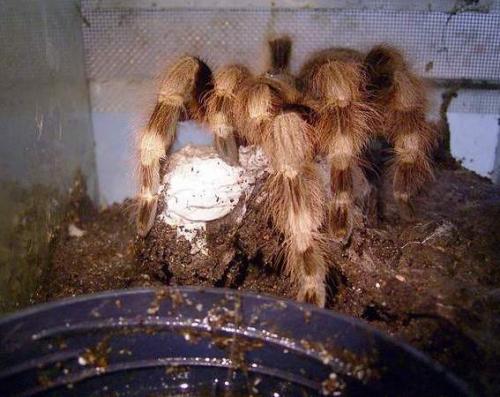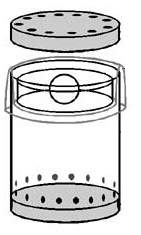Incubation
For successful developments of cocoon (eggsac) and hatchling of young tarantulas (spiderlings) it is necessary to create the three main conditions - temperature 27-28°С, constant maintenance of humidity not lower than 60-70% (information on upper limit is absent) and regular overturning of eggsac.
Its possible to define two main variants of incubation of eggsac: leaving its with female (natural incubation) and artificial incubation.
Natural incubation. As it was already mentionned earlier, in this case cocoon remains in female`s care and all troubles about maintenance of eggs viability and their successful development "lies on her shoulder".
 Here any additional interference is excessive. On the contrary, it is necessary to exclude any possibility of enxiety of female. It is required only to support a necessary temperature-humidity mode in terrarium and provide a regular presence of food objects, because it is noticed that absences of food for a long-lasting time during that period may be one of the possible reason for female to eat an eggsac.
Here any additional interference is excessive. On the contrary, it is necessary to exclude any possibility of enxiety of female. It is required only to support a necessary temperature-humidity mode in terrarium and provide a regular presence of food objects, because it is noticed that absences of food for a long-lasting time during that period may be one of the possible reason for female to eat an eggsac.
Artificial incubation.
It can be realized within two main ways: mechanical or manual.
In first method eggsac fits in mechanical incubator, providing all necessary conditions for successful incubation: automatic maintenance of humidity and temperature and also automatic overturning of eggsac 3-5 times per day.
 In second case cocoon inheres in specially made incubator (shown at picture) representing itself cylindrical glass or plastic box with ventilation holes in lower part under which is disposed section with well absorbing and holding the mousture filler (for example, vermiculit). In higher part of box is inserted cylinder, which provides a presence of space between equiped by ventilation lid and nylon insertion (presenting itself resemblance of hammock), to which directly is situated mentioned cylinder. In this cylinder places the cocoon. Overturning is realized manually.
In second case cocoon inheres in specially made incubator (shown at picture) representing itself cylindrical glass or plastic box with ventilation holes in lower part under which is disposed section with well absorbing and holding the mousture filler (for example, vermiculit). In higher part of box is inserted cylinder, which provides a presence of space between equiped by ventilation lid and nylon insertion (presenting itself resemblance of hammock), to which directly is situated mentioned cylinder. In this cylinder places the cocoon. Overturning is realized manually.
Beside majorities of tarantula species cocoon can be removed from females after 21st day when eggs, as a rule, already develop in first stage of nymph. Beside small species, for instance Holothele incei, eggsac can be removed from female at earlier time since the development of eggs goes quicker.
Do not worry if You withdrewed cocoon from females at 21st day, dissected its and have found that eggs did not yet develop in nymph stage. This will occur in the near days (if eggs are fertile).
Accoding to information from Ray Gabriel (2003) the eggs of tarantula species Psalmopoeus pulcher, withdrawn from females at 19th day, have lain in incubator and develop in first nymph stage I just after 7 days.
Here are several words about need of overturning of eggsac, which is realized by female under natural incubation.
In the matter of fact such overturning, which provides a load sharing on egg` shells and pressure of eggs to eggs as well as good ventilation and corresponding necessary influx of air to eggs, needs only if incubation of eggs takes care right in cocoon. Evenly distributed on surfaces of used in incubator covering eggs do not need to be overturn. You only must control the humidity to beёame not very high to allow developing the mold. Opposite, if the sac don't removed from the female it is often mold on one of the side, which is turn to substrate (I faced this fact at half of my terrestrial`s sacs).
The same concerns to first stage nymphs ("eggs with legs"), which do not yet eat and lead the still lifestyle. However under further development, already second age nymphs became mobil and can scatter from incubator.
Nymphs have molted into spiderlings can be separated in personal boxes within several days after the molt.
Note. Accoding to information from Ray Gabriel tarantula Poecilotheria formosa can have even 4 nymph stages (usually, absolute majority of species has 2 larval stages) and it is also known for other species of the same genus - P. metallica and P. miranda to have 3 stages. Probably, it may be explaned with need of delay in emergence of spiderlings to beginning of rain season.
In conclusion lets note that in last decades there are active breeding of tarantulas began in the world hobby. In Chech Republic, Germany, Holland, France, USA and Canada are regularly conducted sellings- exhibitions, conferences where`re collectors and amateurs changes their experience in keeping tarantulas, discuss actual problems and reaches egreements to fill up their own collections.
At present time, in Russia and C.I.S countries the circle of enthusiasts, being seriously keeping and breeding tarantulas in captivity are measly small, special literature is absent, possibility in buying tarantulas is also limited, so the prices of majorities of proposed for sale species are very high, because nearly all of them enters in Russia from abroad.
Only in 2000, after long break in breeding of spiders (casual breedings are known at the beginning of 1990 years, D. Panteleev and I. Zhidov, Moscow (personal communications), and in 1998 - Emil Morozov, Moscow), author, with moscow amateurs Eugeny Yu. Rogov and Igor Arhangelsky, several breeding projects were realized and the follow species were bred: Psalmopoeus cambridgei, Avicularia sp. "huriana", A. versicolor, Lasiodora parahybana, Brachypelma albopilosum, B. sp. "vagans", Haplopelma lividum, H. schmidti, "Nhandu chromatus", Stromatopelma calceatum, Acanthoscurria sp. "musculosa", A. broklehursti, Nhandu coloratovillosus, Grammostola rosea, Chromatopelma cyaneopubescens etc.
Several other keepers for last 2-3 years were also successful in breeding tarantulas as well, so we can consider the hobby became much popular in Russia and spiders became some not unusual "pets" nowadays.
In the near future realization of some other breeding projects are planned.